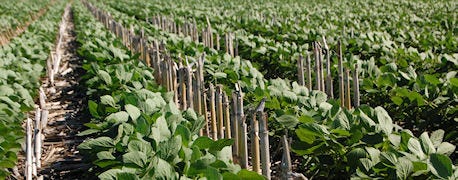December 31, 2013

On-farm research in Pennsylvania has long shown corn yield increases following cover crops. Now, a new national study confirm 10% corn yield increases and 14% better soybean yields – even in drought seasons.
That's the bottom line of a 750-farmer survey by the Conservation Technology Information Center and USDA's Sustainable Agriculture Research and Education program. In a year when drought pushed national corn production estimates down by more than 40 bushels an acre, cover crop users reported an average increase of 11 bushels of corn per acre and an average bump of 4.9 bushels of soybeans per acre in fields with cover crops.

SOIL HEALTH-BUILDING: This cover crop stand of red clover, tillage radish and ryegrass was interseeded on June 27 in southern New York.
The 2012 crop year yield comparisons come from a 2012-2013 survey of farmers who use cover crops, comparing yield information from fields similar in nature -- one field planted to cover crops and the other in similar conditions and rotation but not planted to cover crops.
In percentages, those extra bushels represent an average 9.6% greater corn yield after cover crops and an 11.6% increase in soybeans. When yields were compared in 7 states from Nebraska to Indiana hit hardest by drought in 2012, yield differences were even higher, says Rob Myers, regional director of Extension for the North Central Sustainable Agriculture Research and Education program at the University of Missouri.
Organic matter, protective blanket held moisture
With increased organic matter, the residue blanket of cover crops and no-till, spring soil moisture lasted longer, explains Myers. "And, corn and soybean roots followed the deeper roots of cover crops to where the moisture was later in the season."
Two take-home messages arose from the survey: Cover crops can be helpful in weather extremes, and that this group of farmers is concerned about soil health. "This," he says, "indicates a new way of thinking by farmers."
Myers characterizes the farmers who took the survey as early adopters of conservation practices. They ranged from farming a few hundred acres of corn and soybeans to several thousand acres, and from first-year cover crops to some who had grown cover crops for many years.
"Controlling soil erosion and using legumes to add nitrogen to the soil are long-standing reasons for using cover crops," he adds. "But in this survey, reducing compaction was the number one reason for using them. Scavenging nutrients was also high on the list."
Survey results pointed out farmers were willing to pay $15 an acre to get cover crops seeded, in addition to seed costs. And there was more aerial seeding of cover crops in late summer and early fall to try to get them established in moisture.
You May Also Like




